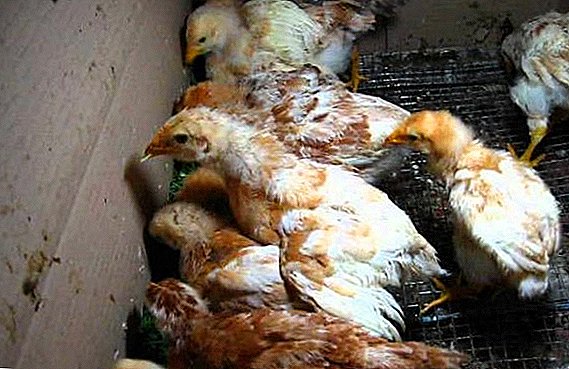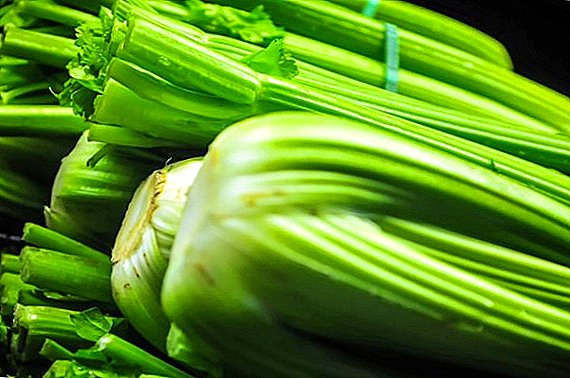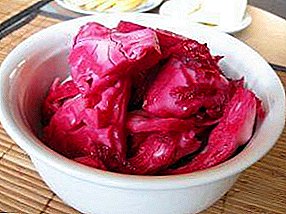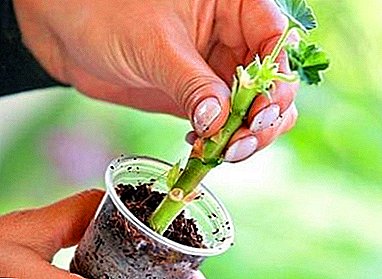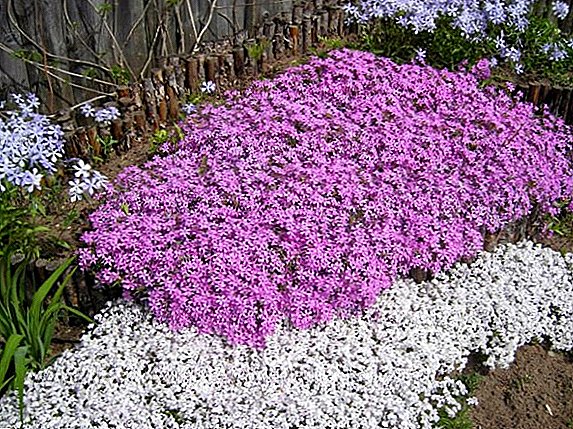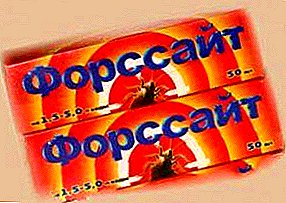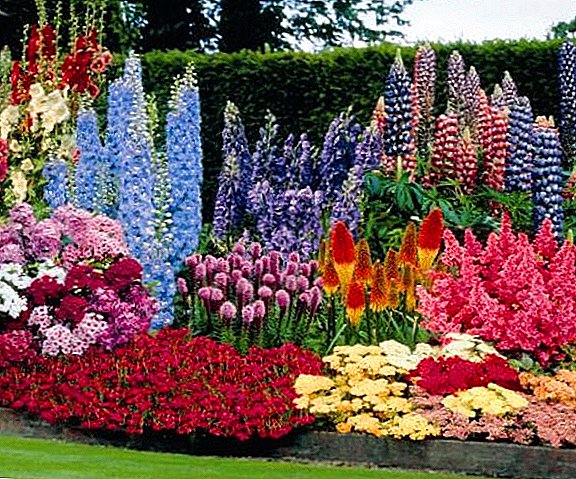 The decoration of the backyard plot becomes a top priority for many summer residents, and decorative flowering plants can help them in this. So, garden flowers (especially perennials) are the main aesthetic complement of any territory, pleasing the eye with a whole set of various colors. The choice of a particular plant depends only on your individual preferences and the characteristics of the territory of the suburban area.
The decoration of the backyard plot becomes a top priority for many summer residents, and decorative flowering plants can help them in this. So, garden flowers (especially perennials) are the main aesthetic complement of any territory, pleasing the eye with a whole set of various colors. The choice of a particular plant depends only on your individual preferences and the characteristics of the territory of the suburban area.
The benefits of perennial flowers
It is no secret that annual plants have a unique palette of a wide variety of colors that delight you throughout the season. However, an increasing number of gardeners prefer perennial plantsblooming for a longer time. This is not surprising, because, in addition to the possibility of long-term cultivation in one place (they can do fine without a transplant for 2-3 years), they also have a number of other advantages, among which it is worth highlighting:
- high frost resistance (plants tolerate winter well);
- unpretentious in terms of care;
- ability to maintain decorative qualities throughout the season;
- ideal for the basis of most mixed flower beds.
Moreover, it is impossible not to note the material benefits of landscaping the site with the help of perennial plants: after a few years, you can safely divide the bushes for the purpose of selling, exchanging or creating new compositions.
Often beautiful perennial flowers are grown in summer cottages for future bouquet cuttings, but even in this case it is necessary to have accurate information regarding the characteristics of the growing conditions of a particular plant. Depending on the type, the flowers are characterized by good growth on neutral and acidic soils, as well as wet, dry, clay (heavy) and sandy (light) soils. Different plants and lighting requirements. While some of them are light-loving colors, others prefer shaded areas. The most effective flower beds of perennials, placed in tiers and grouped by height.
Tall perennials
High perennial flowers for gardening and gardens can reach a height of 3 meters, making it look great both in mono plantings and as a natural decoration or background when creating mixborders. Considering that the vegetative processes of high perennials take place for quite a long time, the peak of their development accounts for more in the second half of summer. The most common types of such plants include the following flowers.
Astilba
Astilboy called a perennial herbaceous plant belonging to the family kamnelomkovyh. Its homeland is Japan, but it is often found in East Asia or North America. It reaches a height of 200 cm and is distinguished by large leaves that form an openwork dark green, burgundy or bronze bush. Flowers of astilbe are collected in panicle-shaped inflorescences from 10 to 60 cm long, and white, red, pink and purple shades are characterized by special attractiveness (flowering period is June-August). The fruit is presented in the form of a box with small seeds.  As for the characteristics of planting and care, this plant prefers semi-shaded areas with rich soil, regular watering and timely removal of peduncles (immediately after the flowering period).
As for the characteristics of planting and care, this plant prefers semi-shaded areas with rich soil, regular watering and timely removal of peduncles (immediately after the flowering period).
Delphinium
Among the popular perennial flowers for giving, it is impossible not to isolate the delphinium, a herbaceous plant of the buttercup family. Africa is considered the birthplace of this proud handsome man, where annual species are common along with perennials (over 300 in total). The height of the delphinium reaches 250 cm, and the flower itself is characterized by palmate-separated, repeatedly-palchato-dissected, palmate-dissected or slightly wavy leaves, which are arranged in a regular manner, mainly in the lower part of the plant.  The flower is simple, non-double, complemented by five colored sepals, the top of which has a spur. Inside the flower are two petal-shaped nectaries and two small petals - staminodes. Their color is different from the color of sepals, because of which these petals are also called bees or peepholes. The main task of staminodes is the attraction of pollinating bumblebees.
The flower is simple, non-double, complemented by five colored sepals, the top of which has a spur. Inside the flower are two petal-shaped nectaries and two small petals - staminodes. Their color is different from the color of sepals, because of which these petals are also called bees or peepholes. The main task of staminodes is the attraction of pollinating bumblebees.
The fruit is presented in the form of single or multileaf with small seeds that remain viable for 3-4 years.
Did you know? Many gardeners compare the undisclosed delphinium with the head of a real dolphin, thanks to which the plant received such a name. However, there is another theory of the appearance of his name. According to legend, it was these flowers that massively filled the Greek city of Delphi.
Lupine
Lupine, like some other plants from the group of tall perennials, has annual and biennial species (there are about 200 varieties in total), mostly growing in North America and the Mediterranean. The leaves of the lupine are palmate, located on long petioles and collected in the rosette. Flowers are combined in racemes and may have a white, yellow, blue, purple, pink, cream, red or purple hue. The fruit is presented in the form of a bean, and depending on the type of plant it can be from 8 to 180 seeds per 1 gram.  Species diversity of this perennial is so great that it is very difficult to choose one specific variety. However, the majority of summer residents stop their attention on plants whose inflorescence is close to wild, original species. Usually, blue, blue with white or pink lupins are found on the territory of private estates, although there are much more interesting garden forms of this plant.
Species diversity of this perennial is so great that it is very difficult to choose one specific variety. However, the majority of summer residents stop their attention on plants whose inflorescence is close to wild, original species. Usually, blue, blue with white or pink lupins are found on the territory of private estates, although there are much more interesting garden forms of this plant.
Uvolistny sunflower
No less effective addition to any home flower garden can be willowy sunflowerdecorated with elegant flowers in the form of saucers (diameter 5-7 cm). It belongs to perennial herbaceous plants, reaching a height of 1.8 to 3 meters, and is characterized by upright, strong, rigid stems, branched at the base. In some species, they are completely naked, while others are softly fleecy, purple, with a thick bluish bloom.  The leaves of the sunflower alternate, curved in the form of an arc, narrowly linear, and reach a length of 15-20 (sometimes 30) cm. The lowest leaves are located on short petioles.
The leaves of the sunflower alternate, curved in the form of an arc, narrowly linear, and reach a length of 15-20 (sometimes 30) cm. The lowest leaves are located on short petioles.
The baskets of the plant are numerous, gathered in large panicles and are 4.5-7.5 cm in diameter. Reed flowers located at the edge have a thick golden-yellow color. Also, the plant is notable for numerous purple (rarely yellow) disc flowers.
Thickets of ornamental sunflower, with golden-brown flowers, which are located on the stems 2.5 meters long, are often visible far beyond the site.
Important! The key to a beautiful and abundant flowering of this species of perennial plants is a warm and hot summer.
Steward
Another impressive addition to any garden is rightly considered a facie. This rhizomatous plant has more than 600 species, among which there are grassy and semi-shrub varieties (mostly perennials). Widely distributed in Europe, Asia, Africa and America, although in our country it is not difficult to meet him. The stems of the plant are straight, the leaves are arranged oppositely, sometimes in a regular order. The flowers are small, tubular and may have the most diverse color: white, pink, bluish-purple or purple. They are collected in baskets (inflorescences) and form complex racemes or corymbose inflorescences.  The pedigree reaches its peak of attractiveness when large inflorescences appear on the bushes, although even after the flowering stops, it is especially interesting because it acquires a white-silver color. Plants are blooming as one of the last inhabitants of the garden, which makes them excellent partners for large decorative cereals.
The pedigree reaches its peak of attractiveness when large inflorescences appear on the bushes, although even after the flowering stops, it is especially interesting because it acquires a white-silver color. Plants are blooming as one of the last inhabitants of the garden, which makes them excellent partners for large decorative cereals.
Important! The characteristic distinguishing feature of boneset is late regrowth. That is, if with the arrival of spring the plant does not show for a long time - do not be in a hurry to get upset. Before finally leaving the winter sleep, the pedigree will wait for the frosts to stop, and only after that (around mid-May) will they begin to grow rapidly.
Tricyrtis
Tricyrtis has been known since the 9th century, however, it gained wide popularity only in the middle of the 20th century. This plant prefers half-shaded forest areas and soil rich in humus. In total, there are about 20 species of these perennials, and almost all of them have high decorative properties, and the small diameter of the flowers is not a hindrance to this.
The stem is erect, thin and reaches a height of 50-70 cm. To it are attached leaves of lanceolate-oval shape with light specks that do not have petioles familiar to us.  Flowers are small plants (about 3-5 cm), funnel-shaped and located in the axils of the leaves and at the top of the stem. They can be presented in the form of half-umbrellas or assembled in bunches. Tricyrtis is distinguished by the most diverse color of flowers: white, cream, pink, with characteristic spots or without them. Some species have a nectar spur.
Flowers are small plants (about 3-5 cm), funnel-shaped and located in the axils of the leaves and at the top of the stem. They can be presented in the form of half-umbrellas or assembled in bunches. Tricyrtis is distinguished by the most diverse color of flowers: white, cream, pink, with characteristic spots or without them. Some species have a nectar spur.
Important! Among all the types of plants described, winter-hardy species are very few. The most common of these is the short-haired tricyrtis, presented in the form of a low bush (it grows up to 1 meter).
Rudbeckia
This perennial plant is something like a daisy, but grows up to 200 cm (some wild species can reach three meters). Rudbeckia has simple or hard-stemmed stems and whole leaves (can be pinnately dissected or pinnipotent). They are oval or ovoid and often reach 25 cm in length. In the upper part of the stem leaves are sessile, and from below they are attached to the base with the help of a stem.  The inflorescences consist of marginal fruitless reed flowers of various colors (from yellowish to brown or purple-black). The fruit is an oblong seed, sometimes supplemented with a small crown. Small and brilliant seeds of this plant are able to remain viable for 2-3 years.
The inflorescences consist of marginal fruitless reed flowers of various colors (from yellowish to brown or purple-black). The fruit is an oblong seed, sometimes supplemented with a small crown. Small and brilliant seeds of this plant are able to remain viable for 2-3 years.
The abundance of bright yellow inflorescences of Rudbeckia has no equal. Flowering begins at the end of summer and continues until late autumn.
Stock rose
Mallow, or stock-rose belongs to the group of perennials, although most often it is grown as a one or two year old. This species stands out with beautiful blooms and heights of up to 2.5 meters. Mallow flowers are oboepolymi and differ in a variety of shades: from white and gently pink to red, purple or lilac. Their rim is five intergrown petals with a five-groove cup. There are also many stamens, which have grown together in a tube and attached to the corolla (they fall together with it). The leaves are located on a grassy stem in the regular order, and the fruits are presented in the form of cakes (dry boxes formed by sepals). Mallow seeds are easily spread with shoes, horses' hooves and with the help of other animals. 
Echinacea
If not all gardeners may be familiar with the perennials described earlier, then Echinacea is surely known to people not associated with growing plants. This medicinal flower can serve not only as a decoration of a garden or flower bed, but also be used to combat a variety of diseases. It contains beneficial substances such as calcium, selenium, zinc, silver, lithium, copper and other trace elements. As for the decorative properties of echinacea, this tall (can reach 1.5 meters in height) perennial with beautiful purple flowers will be an excellent background for any flower bed. The stems of the plant are densely covered with leaves and strongly branched, growing rapidly throughout the territory. The number of leaves decreases to the top of the stem, on which there is a flower basket with a receptacle in the shape of a ball. Fruiting echinacea is performed by tubular flowers located in the center of the basket. 
Perennial perennials
Sredneroslye perennials - a win-win for any garden or suburban area. Such plants reach a height of 80 cm, thanks to which they are an excellent component of various flower compositions.
Mountain cornflower
One of the most common perennial perennials in our area is the mountain cornflower. Its unbranched straight stem reaches 60 cm in height and ends with a flower of blue or blue-violet color. Leaves -root and stem, whole, collected in the outlet. Flower baskets are represented by single inflorescences, reaching a diameter of 6 cm. The period of active flowering of cornflower falls on June-August.  This unpretentious perennial with creeping rhizome is a great option for those gardeners who can deal with plants only on weekends.
This unpretentious perennial with creeping rhizome is a great option for those gardeners who can deal with plants only on weekends.
Did you know? Mountain cornflower as an ornamental plant began to grow from the end of the XVI century.
Irises
Irises belong to the genus of rhizomatous perennial plants from the family of Corridor. In total, they have about 700 types of flowers of various shapes and shades. On the rhizome of the iris there are cord-shaped or filiform roots, but on the stem there are no habitual leaves (they are all flat, thin, double-rowed and collected by fan bundles at the base of the peduncle). The flowers of the plant are quite large, solitary and sometimes collected in small inflorescences. They often differ in an intricate form and can be painted in a wide variety of color combinations. Each flower has six petals, of which the three outer ones are turned to the bottom and differ in color from the upper lobes, which are fused to form a tube. Iris blooms from May to July, when two or three flowers simultaneously bloom for one to five days. The fruit of the plant is represented by a three-capsule box. 
Daylilies
Like irises, daylilies belong to the herbaceous rhizome perennials, although in appearance these plants have significant differences. The accessory roots of the daylily are cord shaped and rather fleshy, which helps the plant to cope with the drought. The leaves are broadly linear, double-rowed and located at the root itself, while the large flowers are six-fold and most often have a funnel-shaped form. They can be orange, yellow or red-brown, collected in clusters of several pieces. At the same time blooms up to three flowers, and the total duration of flowering bush for more than three weeks. Peduncles leafy and in height can reach from 30 cm to one meter. The fruit is represented by a triangular box with seeds inside. 
Pion
Peony is another representative of perennial herbaceous plants. He belongs to the family of Pionov, although previously it was attributed to the Buttercups. Flowering occurs at the end of spring, although shrubs are valued not only for showy flowers, but also for lush foliage and ornamental fruits. (characteristic only for some species).
The plant can be represented as perennial herbaceous, semi-shrub, and shrub species with several stems (trunks) whose height reaches 1 m. The rhizome of a peony is quite large and consists of powerful, thickened cone-shaped roots. The leaves are dark green (less often gray-gray, and yellow, brown, reddish, or dark-violet in autumn) non-paristera-seperate or ternate, supplemented with narrow or wide lobes. The diameter of single peony flowers with single calyx and corolla reaches 15-25 cm, although in some cases they may be even larger.  As for colors, in most cases, the flowers of the plant are white in color, although they can often be pink, red, cream or yellow, sometimes with dark spots at the base. The fruit of the pion is represented by a complex star-shaped multi-leaf, each leaflet opens strictly along the seam and has several seeds that are attached to the edge of the abdominal suture.
As for colors, in most cases, the flowers of the plant are white in color, although they can often be pink, red, cream or yellow, sometimes with dark spots at the base. The fruit of the pion is represented by a complex star-shaped multi-leaf, each leaflet opens strictly along the seam and has several seeds that are attached to the edge of the abdominal suture.
Peonies are often found not only near private estates, but also in park areas, where, if they create optimal conditions for their growth and development, they can live up to fifty years.
Yarrow
This medium-high perennial plant is very popular among the owners of summer cottages who like to make flower beds. The fact is that inflorescences of yarrow have a bright color (shades can be red, white, cherry, orange, yellow or white) and for a long time retain an attractive appearance.  Today there are about two hundred species of this plant, and in places of its greatest natural distribution there are mountain meadows and rocky, rocky terrain.
Today there are about two hundred species of this plant, and in places of its greatest natural distribution there are mountain meadows and rocky, rocky terrain.
Important! Yarrow successfully endures both sudden temperature changes and periods of prolonged drought, which makes it an ideal plant for the "lazy."Some species (for example, yarrow, large-headed) can reach a meter height, but most of the plants grown in gardens do not exceed 60 cm.
Phlox
In terms of growing conditions, phloxes are perennial flowers that can calmly spend the winter in the garden. Thanks to the work of breeders, the number of phlox varieties is increasing every year, and these elegant and bright plants become obligatory inhabitants of ornamental flowerbeds of country sites.
Depending on the type of plant (totaling about 85), the stems can reach from 10-20 cm to 120-150 cm in height. The leaves of the plant are entire, sessile, ovate-lanceolate or ovate-elongated, located oppositely.  The form of flowers is tubular-funnel-shaped, and they are no more than 3-4 cm in diameter. The number of flowers in the inflorescence usually reaches 90 pieces. There are only five petals, and they are all bent at a right or almost right angle to the tube, thereby forming a flat rim of various shapes (notched, stellate, saucer-shaped, or deeply dissected). The color of the corolla can also be completely different, from pure white and white with eyes, dots, strokes, shadows to raspberry red purple and dark purple violet. Most often, the flowers are collected in complex inflorescences, which are located at the ends of the shoots.
The form of flowers is tubular-funnel-shaped, and they are no more than 3-4 cm in diameter. The number of flowers in the inflorescence usually reaches 90 pieces. There are only five petals, and they are all bent at a right or almost right angle to the tube, thereby forming a flat rim of various shapes (notched, stellate, saucer-shaped, or deeply dissected). The color of the corolla can also be completely different, from pure white and white with eyes, dots, strokes, shadows to raspberry red purple and dark purple violet. Most often, the flowers are collected in complex inflorescences, which are located at the ends of the shoots.
Different types of phlox can have their individual morphological features, because of which they were divided into three main groups: shrub, rylodernova and creeping. In turn, bush plants can also be divided into two subgroups: tall and short.
Undersized perennials
Low-growing plants, which also belong to perennial species, reach 30 cm in height and can be an excellent complement to the floral composition along with medium-tall and tall perennials with spectacular flowering.
Pansies
Speaking of stunted perennials, one can not mention the pansies, or, as they are called, - viola. This plant is characterized by a huge number of possible colors, ranging from rich white and ending with a blue, yellow, or even black tint. The bright and iridescent flowers of the viola are similar to multi-colored children's dresses, both made in the same color range, and with a predominance of "spotting" or "banding."  The root system of this plant is of the fibrous type, and the main shoot belongs to the upright species. Viola leaves are simple or pinnately dissected, supplemented by stipules, or collected in the rosette (sometimes they can also grow alternately). The flowers of the plant are axillary, solitary and are placed on long peduncles. They reach 7 cm in diameter. Their upper petals have marigolds, and the lower ones are larger and are supplemented at the base with a sacculate formation.
The root system of this plant is of the fibrous type, and the main shoot belongs to the upright species. Viola leaves are simple or pinnately dissected, supplemented by stipules, or collected in the rosette (sometimes they can also grow alternately). The flowers of the plant are axillary, solitary and are placed on long peduncles. They reach 7 cm in diameter. Their upper petals have marigolds, and the lower ones are larger and are supplemented at the base with a sacculate formation.
"Pansies" reach 15-30 cm in height, due to which they become an excellent perennial plant, used to create a decorative border. Viola blooms from mid-March until the end of May, or from August to the most frost.
Primorye Armeria
A perennial plant belonging to the family Gillet. In nature, there are about 90 types of armies, many of which are an excellent option for landscape design (often adorned with rockeries, rock gardens and rock gardens). The height of the seaside army reaches 15-20 cm, and about the same size of the plant is in diameter. The leaves are narrow, 0.3–1.5 mm wide and 2–8 cm long, flat, blunt and colored blue-green. Flowers Armeria collected in capitate inflorescences and have a purple-pink color. Cover up the flowers membranous bracts. Peduncles of plants reach 20 cm and are characterized by characteristic pubescence.  Flowering plant occurs within 70 days, which begins in May. In some cases, the army can bloom again - in the fall, although this happens infrequently. Growing in the garden, the Armeria forms thick low thickets, somewhat reminiscent of small mounds. In combination with other plants, they form an excellent composition.
Flowering plant occurs within 70 days, which begins in May. In some cases, the army can bloom again - in the fall, although this happens infrequently. Growing in the garden, the Armeria forms thick low thickets, somewhat reminiscent of small mounds. In combination with other plants, they form an excellent composition.
Periwinkle
Periwinkle belongs to creeping and climbing plants of ground cover type. He is able to quickly grow in breadth, forming new sections of the root system. There are two types of plants: small periwinkle (reaches a height of 20-35 cm) and large periwinkle, which can grow to a height of 1 meter. In the first case, the plant is represented by an evergreen shrub with a vertical arrangement of fruit-bearing and fruitlessly creeping stems. The leaves of this perennial have a leathery structure and are distinguished by a glossy surface of dark or light green color. In some cases, the leaves may be covered with cream or golden spots.  As for the single flowers of the plant, they attract the eye with their impressive size and beautiful blue color. The calyx is small and deeply pentamere, and the corolla is funnel-shaped, with a five-part spike-shaped bend. Two cylindrical leaflets act as a fruit.
As for the single flowers of the plant, they attract the eye with their impressive size and beautiful blue color. The calyx is small and deeply pentamere, and the corolla is funnel-shaped, with a five-part spike-shaped bend. Two cylindrical leaflets act as a fruit.
Periwinkle is an unpretentious plant, but the main condition for its normal growth is timely watering and the absence of drying. In addition, it is recommended to periodically trim the bushes, and in the conditions of severe winters it is better to cover them. Proleski, hyacinths, geyhery and primroses, with which the periwinkle will look as harmonious as possible, will perfectly suit as "neighbors".
Carnation grass
A perennial plant also includes a carnation grass, low stalks of which spread to a height of 40 cm above the ground. Due to this growth, the plant is often used to cover the soil, which also contributes to the possibility of rooting stems throughout the growing season.  Travyanka leaves elongated, small, gray-green color. The flowers are also small in size (up to 1.5 cm in diameter) and are painted in bright red or red-white color. They can be either single or collected in oblong little-flowered inflorescences. In appearance they resemble wild-looking carnation flowers, which are often found in the steppe zone. Flowering begins with the arrival of summer and lasts 40-45 days, so the optimal time for its landing in the ground is considered to be the period from May to July. At home, if all the requirements for caring for cloves are met, the grass can live in one place for up to 4-6 years.
Travyanka leaves elongated, small, gray-green color. The flowers are also small in size (up to 1.5 cm in diameter) and are painted in bright red or red-white color. They can be either single or collected in oblong little-flowered inflorescences. In appearance they resemble wild-looking carnation flowers, which are often found in the steppe zone. Flowering begins with the arrival of summer and lasts 40-45 days, so the optimal time for its landing in the ground is considered to be the period from May to July. At home, if all the requirements for caring for cloves are met, the grass can live in one place for up to 4-6 years.
Gentian
The gentian attracts the human eye with beautiful blue bells, which are especially noticeable in the summer season - the period of active flowering of the plant. This flower feels good on the alpine hills, and due to the low growth of many species (from 20 cm) it can well complement any floral arrangement of your garden. The group of this genus of perennials includes more than 400 varieties and varieties.  Usually, the stalk of the gentian is straight and short, the root is short and thick, complemented by many thin cord-shaped roots. The leaves are opposite, whole and sessile, and the flowers are small and solitary, often painted blue, blue or purple. Gentian fruit is presented in the form of a bivalve capsule, growing from a single nesting ovary (there are small seeds inside it).
Usually, the stalk of the gentian is straight and short, the root is short and thick, complemented by many thin cord-shaped roots. The leaves are opposite, whole and sessile, and the flowers are small and solitary, often painted blue, blue or purple. Gentian fruit is presented in the form of a bivalve capsule, growing from a single nesting ovary (there are small seeds inside it).
Like many other short-growing plants, gentian requires a careful attitude to itself, especially in terms of fertilizing. However, observing all the requirements of agricultural technology, you will decorate your site with a beautiful and delicate floral carpet.
Saxifrage
The perennial plant kamnelomka is represented by about 250 species of various flowers scattered throughout the world. About 80 of them are found in the middle lane, and many belong to ornamental crops, excellent for cultivation in the garden or at their summer cottage. 
Did you know? The name of the plant comes from the peculiarities of its way of "living" in natural conditions. Getting into the crevices of the cliffs, the saxifrage destroys the rock with its roots. Hence the second name - "gap-grass".
Low-growing species reach a height of 10–20 cm (for example, the popular stone-sawdog of Arends) and form a low-growing decorative rug on the ground. The leaves of the plant may have a different shape (rounded or slightly elongated) and surface type, differing in density and fleshiness. Color varies from dark green to gray-green. The flowers are small and collected in paniculate or racemose inflorescences, white, red or pink color.
Flax perennial
The number of flax varieties reaches 230 species, among which there are both annual and perennial plants of interest to us. The latter often include flax and perennial, growing to 80 cm and characterized by small blue, white or blue flowers. The time of their active flowering occurs in June-July.  The erect flowering stalks of the plant are arranged in small groups and can be either very thin or more powerful, cylindrical in shape. The leaves of flowering shoots reach 0.4-5 cm in length and about 3 mm in width. For the most part they are erect or slightly protruded in the horizontal direction, linear or linear-lanceolate, of a bluish tinge or almost completely green.
The erect flowering stalks of the plant are arranged in small groups and can be either very thin or more powerful, cylindrical in shape. The leaves of flowering shoots reach 0.4-5 cm in length and about 3 mm in width. For the most part they are erect or slightly protruded in the horizontal direction, linear or linear-lanceolate, of a bluish tinge or almost completely green.
Inflorescences are represented by many-flowered curls with shortish, but wide leaves on them. The flowers of perennial flax are relatively small in size and reach 2-3 cm in diameter. They are located on erect short pedicels, which are 2-3 times longer than the sepals.
Care for this type of plant is easy, and the main requirement is timely weeding from weeds.
Stahis
The Chinese artichoke, or Chist shrine, or, more simply, stachis, is a common name for a whole group of perennial plants that belong to the family of Gouboths. In nature, there are about 300 different types of Stachises, among which are found both wild and ornamental plants.
In the latter case, the most popular type is the woolly chistets - a small shrub that reaches 30-60 cm in height. His spectacular gray-green leaves, densely covered with silver-gray villus, and pale pink or pale lilac flowers will be an original addition to any flower bed. Flowers collected in inflorescences resemble ears of 20 cm in length. The plant blooms from June to September, and in warm climatic conditions, stahis also forms a multitude of seeds, by means of which its natural reproduction takes place.  Highly popular in landscape design Chisty is obliged to the unusual color and texture of the leaves, which are able to give the site a refined and noble look. It is planted as a curb and ground cover plant, although it also looks great in mixed plantings, rockeries and alpine slides.
Highly popular in landscape design Chisty is obliged to the unusual color and texture of the leaves, which are able to give the site a refined and noble look. It is planted as a curb and ground cover plant, although it also looks great in mixed plantings, rockeries and alpine slides.
Summarizing all the above, it should be noted that the structure of any flower bed is determined more by tall perennials, which can be used both in single plantings and in small groups.
Next to tall plants, it is always necessary to plant one or several more stunted neighbors (medium perennials), which will be well combined with them in shape and color.
If at the same time there are still holes in the flowerbed, you can close them with low-growing perennial plants, because if you observe a certain distance between neighbors for several years, they will cover the flowerbed with a dense “living” carpet.



